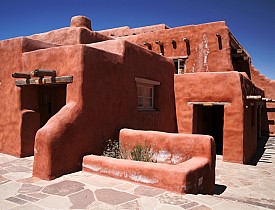Cob Construction Could Be for You

Cob construction may be the world's most environmentally friendly building process. There are no additives or chemicals. No energy is consumed in heating or forming the material, and no heavy machinery is required. In the right areas, the basic building materials all can be obtained locally.
What is Cob Construction?
The process of cob construction is like shaping a house with artists' clay but never baking it. "Cob" (which borrows an Old English word for mound and has nothing to do with corn) is a mass of straw, clay, sand, and water. In a gradually reviving form of home building, it is hand-sculpted into buildings while the mixture is still wet.
Cob was used for many years in Europe, and is still widely used in Africa. Many European earth structures are still standing despite centuries of rain and harsh winters.
It is closely related to adobe, a popular building style in the Southwestern United States. The main difference is bricks. Adobe uses sun-dried earth bricks connected with mud mortar. Cob construction is a simpler concept, but takes detailed planning.
Here are the important first steps of cob construction.
Choose a Site
The most important factor is drainage. Cob will break down if it is submerged. Make sure that even a 1,000-year flood won't saturate your cob walls.
Instead, build on a hill to ensure good drainage. Cob works well on sloped properties that complicate standard frame construction. Also look for full sun exposure in the winter, and land with available clay soils, if possible.
Design Your House
Spend plenty of time designing every inch and each curve of a cob house. Make a scale model of the house, including surrounding trees and landscape features. Without four-foot sheets of drywall and other pre-measured supplies to confine the project, much of the house can be as creative as your imagination.
Thoroughly consider lighting and insulation. Take advantage of natural solar light and heat, and design thick walls with embedded straw-bale insulation where needed. After creating a design and consulting with cob experts, obtain the proper building permits (even though very few municipal housing codes explicitly cover cob construction).
Gather Materials
You can't just buy cob mix at a home improvement store, but you may be able to find the materials for free or really cheap. All but the richest agricultural soils and rockiest mountain landscapes have some mix of sand and clay. If either material is not immediately available, look for road projects or construction sites where they may be looking to get rid of clay and sand. Farmers often sell cheap straw bales. As long as the straw is not rain-rotted, it should hold the sand and clay together nicely. With materials in hand and a model of the house, you're ready to build.
Find Help
Cob is an eco-friendly, flexible method of building a house. However it does take time and effort. The process will go much faster if you enlist a little help. Maybe some like-minded friends will be interested in an old-school house raising bee. Or you might want to hire a green-minded contractor.
Building with Cob: More Info
Cob construction is an old, simple and environmentally friendly building technique that is new to most of us. For cob building workshops and classes, and other information, visit the Cob Cottage Company. "The Hand-Sculpted House" by Ianto Evans, Michael Smith and Linda Smiley, is a detailed cob construction handbook that provided background information for this article.
Photo credit: http://www.cobcottage.com
Updated October 9, 2018.
Looking for a Pro? Call us (866) 441-6648

Carpentry Average Costs
Carpenters Experiences

My Deck Repair Was Simple But Perfect

Time To Replace The Heat Pump – Before It Broke Down Completely



